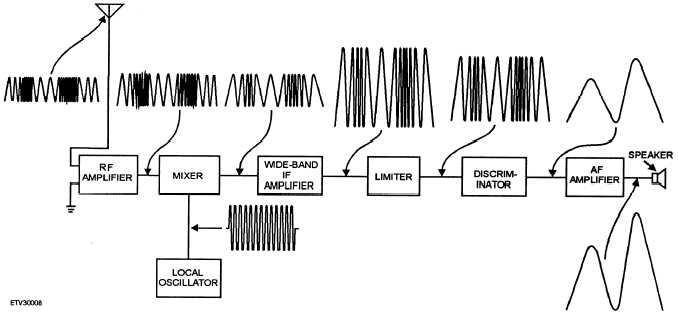and tuned. Measurement of selectivity is usually done
by taking a series of sensitivity readings in which the
input signal is stepped along a band of frequencies
above and below resonance of the receiver’s circuits.
As the frequency to which the receiver is tuned is ap-
proached, the input level required to maintain a given
output will fall. As the tuned frequency is passed, the
input level will rise. Input levels are then plotted
against frequency. The steepness of the curve at the
tuned frequency indicates the selectivity of the re-
ceiver.
Fidelity
Fidelity is a receiver’s ability to reproduce the in-
put signal accurately. Generally, the broader the
bandpass, the greater the fidelity. Measurement is
taken by modulating an input frequency with a series
of audio frequencies and then plotting the output
measurements at each step against the audio input.
The curve will show the limits of reproduction.
Good selectivity requires a narrow bandpass. Good
fidelity requires a wider bandpass to amplify the outer-
most frequencies of the sidebands. Knowing this, you
can see that most receivers are a compromise between
good selectivity and high fidelity.
AM SUPERHETERODYNE
RECEIVER
The superheterodyne receiver was developed to
overcome the disadvantages of earlier receivers. A
block diagram of a representative superheterodyne re-
ceiver is shown in figure 1-7. Superheterodyne receiv-
ers may have more than one frequency-converting
stage and as many amplifiers as needed to attain the de-
sired power output.
FM SUPERHETERODYNE
RECEIVER
Fundamentally, FM and AM receivers function
similarly. However, there are important differences in
component construction and circuit design because of
differences in the modulating techniques. Comparison
of block diagrams (figures 1-7 and 1-8) shows that
electrically there are two sections of the FM receiver
that differ from the AM receiver: the discriminator (de-
tector) and the accompanying limiter.
FM receivers have some advantages over AM re-
ceivers. During normal reception, FM signals are static-
free, while AM is subject to cracking noise and whistles.
Also, FM provides a much more realistic reproduction
of sound because of the increased number of sidebands.
Figure 1-8.—FM superheterodyne receiver and waveforms.
1-9

